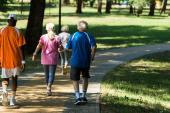A Mix of Aerobic and Strength Exercise Is Best for Boosting Survival
(UPDATED) Combining moderate, vigorous, and muscle-strengthening exercise over the course of each week may be the best strategy.

Achieving a balanced weekly regimen including not only moderate and vigorous aerobic exercise but also muscle-strengthening activities is the best route to lower mortality, data from half a million healthy US adults suggest.
The study, published this week in JAMA Internal Medicine, showed that each of these activity types offers something when it comes to preventing deaths from any cause, cardiovascular disease, and cancer.
“The three types of physical activity may independently contribute to reduce mortality risk,” lead author Rubén López-Bueno, PhD (University of Zaragoza, Spain), told TCTMD in an email. “Therefore, guidelines on physical activity may recommend doing [moderate exercise, vigorous exercise, and muscle-strengthening] on a weekly basis instead of doing one or two types of physical activity.”
This report joins others showing that the cardiorespiratory fitness gained through exercise is protective, even if condensed into a few days per week, while other work has linked muscle-building activities to a healthier, longer life. Still, research also shows an ongoing “pandemic” of inactivity. Many adults live a sedentary lifestyle and are not getting the recommended amounts set by the World Health Organization—at least 150 to 300 weekly minutes of moderate physical activity (MPA), 75 to 100 weekly minutes of vigorous activity (VPA), or an equivalent combination of both plus muscle-strengthening activity (MSA) at least 2 days a week.
“Each and every physical activity component, as detailed in the physical activity guidelines, may have a role in preventing mortality,” said senior author Borja del Pozo Cruz, PhD (University of Cádiz, Cádiz, Spain, and University of Southern Denmark, Odense).
“Interestingly, the optimal amount of each of the physical activity components may be different to prevent cancer or cardiovascular disease mortality,” he wrote in an email to TCTMD. “For the latter, more vigorous activity may be needed. For the former, more moderate activity seems to benefit the most. For both, [a] few sessions of muscle strengthening activity may be required.
Each and every physical activity component, as detailed in the physical activity guidelines, may have a role in preventing mortality. Borja del Pozo Cruz
What’s unique here is that the researchers attempt to look at the effects of three types together, not just alone, said Claudio Gil Araújo, MD, PhD (CLINIMEX, Rio de Janeiro, Brazil).
“They did something very interesting, because they chose to make a combination among three variables—one measured in six ways, another one in four, another one in two—to [arrive at] 48 different exposures that they could compare,” he commented to TCTMD. “This is very unique and very appropriate” as a way to analyze the dataset.
The topic of exercise, rightfully so, is a perennial favorite among the public, Araújo noted. “When you talk about a new drug, a new stent, or other new thing like that, people say: ‘It’s not for me.’ But when you talk about walking or doing resistance training, people say: ‘Okay, well, I was in the gym this morning. Let’s see what they are talking about.’”
Here, he specified, the message is clear: “It is all about really [exercising]. That is, let’s sweat. You have to get sweaty. It’s not only aerobic, but also should include muscle-strengthening activity.” And on top of that, high-intensity activity provides better results, Araújo added.
All-Cause, CVD, and Cancer Deaths
López-Bueno and colleagues turned to the US National Health Interview Survey for data on 500,705 adults (mean age 46.4 years; 58% female; 77% white) obtained between 1997 and 2018. All were free of chronic conditions at baseline. Median follow-up lasted 10 years, with a total of 5.6 million person-years.
Study participants were asked to report the intensity, duration, and frequency of MPA and VPA, as well as whether they did MSA like weight lifting or calisthenics at the recommended level of two times or more each week. The researchers then calculated risk of cardiovascular death for 48 categories looking at various combinations of MPA, VPA, and MSA.
Compared with people who got less than 75 weekly minutes of either moderate or physical activity and didn’t do muscle-strengthening at least twice weekly, different combinations were associated with the lowest risks for all-cause, CVD, and cancer mortality, with muscle-strengthening as a key component.
Largest Survival Benefit vs Inactivity
|
|
Ideal Activity Combination |
HR (95% CI) |
|
All-Cause Death |
MPA > 0-75 min VPA > 150 min MSA ≥ 2x/wk |
0.50 (0.42-0.59) |
|
CVD Death |
MPA > 150-225 min VPA > 0-75 min MSA ≥ 2x/wk |
0.30 (0.15-0.57) |
|
Cancer Death |
MPA > 300 min VPA > 0-75 min MSA ≥ 2x/wk |
0.44 (0.23-0.82) |
Adjusted for age, sex, other demographic factors, comorbidities, body mass index, functional limitations, and survey year, the benefits of these ideal combinations remained significant. There were approximately 50% lower likelihoods of all-cause mortality (4.9 vs 9.8 deaths per 1,000 person-years) and cancer mortality (1.0 vs 2.7 per 1,000 person-years) and a threefold lower likelihood of CVD mortality (0.9 vs 2.9 deaths per 1,000 person-years).
The takeaway, said López-Bueno, is that a mixed approach is best. “Do 150 to 225 minutes of MPA, 10 to 75 minutes of VPA, and two or more MSA sessions per week. If you don´t have time to meet these recommendations, other combinations of physical activity [involving] less time are also valuable,” he explained. “But try to do two MSA sessions, some MPA, and some VPA and don´t focus on one or two types of physical activity solely.”
You have to get sweaty. Claudio Gil Araújo
Similar advice came from del Pozo Cruz, who said: “Do a bit of everything if you can, from light to moderate walking, through to some huff-and-puff activities, including some gym/resistance exercise.”
Next up, López-Bueno said, the researchers would like to look into whether their findings extend to other countries outside of the United States and better pinpoint activity levels by using accelerometry.
Araújo said that although the study overall is “excellent,” it does have some drawbacks. He pointed out that activity levels, though they may change during a person’s life, were ascertained at single time points; male and female study participants, for whom the main cause of death could differ, were lumped together for analysis; activity was quantified in a “crude and simple” way; physical fitness wasn’t evaluated; and some of the baseline characteristics seemed implausible (eg, the 64% prevalence of current smoking in the most-active individuals). Moreover, the popularity of muscle-strengthening activity has grown over the years, but perhaps in ways that aren’t captured by the survey, he added.
For him, the ideal combination includes flexibility and balance training in addition to the three categories studied here. One of Araújo’s own studies, published last year in the British Journal of Sports Medicine, draws a link between survival and the ability to stand on one foot for 10 seconds, for instance.
Exercise, the activity itself, in some ways is just the means to an end, said Araújo. “The target is physical fitness, because physical fitness is the variable related to outcome.”
Caitlin E. Cox is News Editor of TCTMD and Associate Director, Editorial Content at the Cardiovascular Research Foundation. She produces the…
Read Full BioSources
López-Bueno R, Ahmadi M, Stamatakis E, et al. Prospective associations of different combinations of aerobic and muscle-strengthening activity with all-cause, cardiovascular, and cancer mortality. JAMA Intern Med. 2023;Epub ahead of print.
Disclosures
- López-Bueno reports support from the European Union’s Next Generation EU.
- Del Pozo Cruz reports support from the Regional Government of Andalusia’s Research Talent Recruitment Programme.





Comments